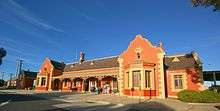Bathurst, New South Wales
| Bathurst New South Wales | |||||||||
|---|---|---|---|---|---|---|---|---|---|
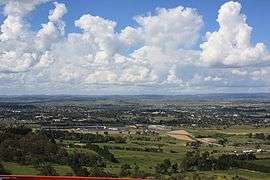 Bathurst skyline | |||||||||
 Bathurst | |||||||||
| Coordinates | 33°25′12″S 149°34′40″E / 33.42000°S 149.57778°ECoordinates: 33°25′12″S 149°34′40″E / 33.42000°S 149.57778°E | ||||||||
| Population | 36,701 (30 June 2016)[1] (13th in NSW) | ||||||||
| Established | 1814 | ||||||||
| Postcode(s) | 2795 | ||||||||
| Elevation | 650 m (2,133 ft) | ||||||||
| Location | 203 km (126 mi) NW of Sydney | ||||||||
| State electorate(s) | Bathurst | ||||||||
| Federal Division(s) | Calare | ||||||||
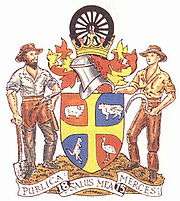 | |||||||||
| |||||||||
Bathurst /ˈbæθəst/ is a regional city in the Central Tablelands of New South Wales, Australia. It is approximately 200 kilometres (120 mi) north-west of Sydney and is the seat of the Bathurst Regional Council. Bathurst is the oldest inland settlement in Australia[2] and had an estimated population of 36,701 as at 30 June 2016.[1]
Bathurst is often referred to as the Gold Country as it was the site of the first gold discovery and where the first gold rush occurred in Australia.[3] Today education, tourism and manufacturing drive the economy. The internationally known racetrack Mount Panorama is a landmark of the city. Bathurst has an historic city centre with many buildings remaining from the gold rush period of the mid to late 1800s.
The median age of the city's population is 34.0 years; which is particularly young for a regional centre (the state average is 36.4), and is related to the large education sector in the community.[4][5] Population growth has reached 1.6% per annum over the five years until 2010, making Bathurst the seventh fastest growing regional city in NSW.[6] This growth over recent years has resulted in increased urban development including retail precincts, sporting facilities, housing estates and expanding industrial areas.
Geography
Bathurst is located on the western edge of the Great Dividing Range in the Macquarie River plain; also known as the Bathurst plains.[7] The city is located adjacent to the Macquarie River which is part of the Murray-Darling basin, the largest river system in Australia. The city is protected by a levee bank to protect the city from occasional flood events. Mount Panorama is located 3 kilometres (1.9 mi) from the CBD and effectively within the city limits; it is 877 metres (2,877 ft) AMSL and rises 215 metres (705 ft) above the Bathurst CBD.
Bathurst is located adjacent to the Great Western Highway which begins in the centre of the city of Sydney and finishes at Bathurst. Within the city, two main state highways start: the Mitchell Highway to Bourke and the Mid-Western Highway to Hay. Bathurst is located approximately mid-way along a regional road route from Canberra and Goulburn to Mudgee and the Hunter Region. Bathurst is also located on the Main Western Railway line that starts at Sydney Central Station and proceeds for 242 kilometres (150 mi) by rail to Bathurst.
The Macquarie River divides Bathurst with the CBD located on the western side of the river. Four road bridges and two rail bridges span the river within the city area. From the upstream side they are: Rail Bridge (built in 1876 [8]) closed in 2011 (replaced with a new concrete single track rail bridge structure alongside and brought into use in 2011); the four lane Evans Bridge which opened in 1995; the Denison Bridge opened in 1870 (closed to road traffic and now a pedestrian bridge); the Gordon Edgell Bridge, a low−level bridge located on George Street; and Rankens Bridge at Eglinton.
Landform
Two physical components comprise the Bathurst region; the Bathurst Basin and the Tablelands areas. They are drained by the Macquarie, Turon, Fish and Campbells Rivers to the north and Abercrombie and Isabella Rivers to the south. The central basin area of the Bathurst area is mainly granite soils while in the north area sandstone, conglomerates, greywacke, siltstones, limestones and minor volcanos predominate. The south is more complex geology with siltstones, sandstones, greywacke, shales and chert, basalt and granite intrusions and embedded volcanic and limestones. Underlying Bathurst is the dominant feature of Bathurst granite (intruded in the Devonian period) and at Mount Panorama and Mount Stewart basalt occurs.[5]
Topography of the region ranges from slightly undulating to rough and very steep country, approximately 30 km to the east of Bathurst is the folded and faulted sedimentary and metamorphosed formations of the Great Dividing Range which runs roughly north-south.[9]
Climate
Due to its elevation, Bathurst has a subtropical highland climate (Cfb), according to Köppen climate classification. Bathurst is in Australia's cool temperate climate zone which is defined as having mild to warm summers and cool to cold winters.[10][11] Regular summer thunderstorms are common, resulting from the flat plains country to the west, leading into the mountainous nature of the country around Bathurst and assisting the development of storm cells.[12] Bathurst gets 106.9 clear days annually.
In winter, light snowfalls typically occur several days each year on the higher peaks around Bathurst, however snow is uncommon in the city itself. On 11 February 2017, Bathurst recorded a new record high temperature of 41.5 °C (106.7 °F) , although temperatures of 40 °C (104 °F) are exceedingly rare for Bathurst.
| Climate data for Bathurst (1909-2017) | |||||||||||||
|---|---|---|---|---|---|---|---|---|---|---|---|---|---|
| Month | Jan | Feb | Mar | Apr | May | Jun | Jul | Aug | Sep | Oct | Nov | Dec | Year |
| Record high °C (°F) | 40.2 (104.4) |
41.5 (106.7) |
35.3 (95.5) |
32.0 (89.6) |
24.2 (75.6) |
20.5 (68.9) |
20.5 (68.9) |
23.5 (74.3) |
29.0 (84.2) |
34.1 (93.4) |
39.7 (103.5) |
37.5 (99.5) |
40.2 (104.4) |
| Average high °C (°F) | 28.1 (82.6) |
27.3 (81.1) |
24.6 (76.3) |
20.2 (68.4) |
15.7 (60.3) |
12.2 (54) |
11.3 (52.3) |
13.0 (55.4) |
16.4 (61.5) |
20.0 (68) |
23.4 (74.1) |
26.4 (79.5) |
19.9 (67.8) |
| Average low °C (°F) | 13.4 (56.1) |
13.4 (56.1) |
10.8 (51.4) |
6.7 (44.1) |
3.4 (38.1) |
1.7 (35.1) |
0.6 (33.1) |
1.3 (34.3) |
3.4 (38.1) |
6.1 (43) |
8.9 (48) |
11.6 (52.9) |
6.8 (44.2) |
| Record low °C (°F) | 1.8 (35.2) |
2.8 (37) |
−2.2 (28) |
−5.0 (23) |
−6.2 (20.8) |
−8.2 (17.2) |
−8.9 (16) |
−7.5 (18.5) |
−5.5 (22.1) |
−3.0 (26.6) |
−1.0 (30.2) |
0.0 (32) |
−8.9 (16) |
| Average rainfall mm (inches) | 67.7 (2.665) |
58.0 (2.283) |
52.1 (2.051) |
42.1 (1.657) |
41.5 (1.634) |
44.7 (1.76) |
49.1 (1.933) |
49.5 (1.949) |
47.2 (1.858) |
59.1 (2.327) |
60.7 (2.39) |
66.1 (2.602) |
637.8 (25.109) |
| Average rainy days (≥ 0.2mm) | 7.4 | 7.0 | 6.3 | 6.2 | 8.3 | 10.2 | 11.2 | 10.9 | 9.3 | 9.3 | 8.5 | 8.0 | 102.6 |
| Average afternoon relative humidity (%) | 42 | 46 | 46 | 49 | 57 | 63 | 61 | 54 | 52 | 48 | 46 | 39 | 50.3 |
| Source: Bureau of Meteorology[13] | |||||||||||||
CBD and suburbs
Bathurst's CBD is located on William, George, Howick, Russell, and Durham Streets. The CBD is approximately 25 hectares (62 acres) and surrounds two city blocks. Within this block layout is banking, government services, shopping centres, retail shops, a park (shown) and monuments.
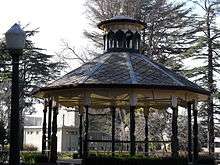
Bathurst has retained a mix of main street shopping along with enclosed shopping centres within the CBD, unlike other towns where the CBD focus has split between main street and new shopping centre developments located in the suburbs. Within the CBD lies Kings Parade; this is a park setting with several memorials of people and events in history. It is a popular location for locals to meet. Keppel Street is Bathurst's second commercial shopping area, removed from the CBD by two blocks to the south. This area developed once the railway arrived in 1876.
The main suburbs of Bathurst are: Kelso, Eglinton, West Bathurst, Llanarth, South Bathurst, Gormans Hill, Windradyne, Windradyne Heights and Abercrombie Estate. One of the newer suburbs is Marsden Estate, in Kelso.[14]
Landmarks
Bathurst's place in Australia's history is evidenced by the large number of landmark monuments, buildings, and parks.
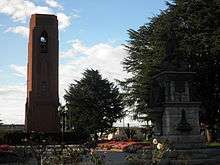
In the centre of the city is a square known as Kings Parade. Originally a market area from 1849 to 1906 , it was redesignated as a public recreation ground and site for a soldiers memorial. Kings Parade now contains three memorials, an open space park and gardens.
The Bathurst War Memorial Carillon is a 30.5 metres (100 ft) tall tower structure located in the centre of Kings Parade. The Parade is located in the centre of Bathurst's CBD. The Carillon is a memorial to the soldiers who lost their lives in the two World Wars. The bell tower contains 35 cast bronze bells that are rung daily at lunchtime, and an eternal flame on the platform level of the structure. The Carillon was officially completed on Armistice Day, 11 November 1933[15] at a cost of £8,880.[16] The Evans memorial stands at the northern end of Kings Parade. Completed in 1920, the memorial commemorates the discovery of the Bathurst Plains in 1813 by George Evans, Assistant Surveyor of Lands. The Boer War memorial stands at the southern end of Kings Parade. This memorial was unveiled in 1910 by Lord Kitchener.
History
The Bathurst region was originally occupied by the Wiradjuri Aboriginal people.
Colonial period (1800s) to gold rush era (1860s)

The government surveyor, George Evans, was the first European to sight the Bathurst Plains in 1813, following the first successful European crossing of the Blue Mountains in the same year. In 1814, Governor Lachlan Macquarie approved an offer by William Cox to build a road crossing the Blue Mountains, from Emu Plains, the existing road terminus west of Sydney, to the Bathurst Plains. The first road to cross the Blue Mountains was 12 feet (3.7 m) wide by 101 1⁄2 miles (163.3 km) long, built between 18 July 1814 to 14 January 1815 using 5 freemen, 30 convict labourers and 8 soldiers as guards. Governor Macquarie surveyed the finished road in April 1815 by driving his carriage across it from Sydney to Bathurst. The Governor commended Cox and stated that the project would have taken three years if it had been done under a contract.[17] As a reward Cox was awarded 2,000 acres (810 ha) of land near what is now Bathurst.
On 7 May 1815, Governor Macquarie at the terminus of Cox's Road raised the flag, ordered a ceremonial volley to be fired and proclaimed and named the future town of Bathurst after the Secretary of State for War and the Colonies, Henry Bathurst, 3rd Earl Bathurst.[18] Bathurst is the oldest inland town in Australia. It was intended to be the administrative centre of the western plains of New South Wales, where orderly colonial settlement was planned.

Local Wiradjuri groups under leaders such as Windradyne resisted the settlers until the Frontier Wars of the early 1820s ended the open conflict.[19] The initial settlement of Bathurst was on the eastern side of the river in 1816. It is in today's suburb of Kelso. Ten men were granted 50 acres (20 ha); five were men newborn in the colony and five were immigrants. These men were William Lee, Richard Mills, Thomas Kite, Thomas Swanbrooke, George Cheshire, John Abbott, John and James Blackman, John Neville and John Godden. In 1818, Governor Macquarie stated in his diary:
This morning I inspected 10 new settlers for Bathurst. I have agreed to grant each 50 acres of land, a servant, a cow, four bushels (141 litres) of wheat, an allotment in the new town, and to receive into the King's Store at Bathurst all the Wheat they can grow for the first 12 months.[20]
In the early years of settlement, Bathurst was a base for many of the early explorers of the NSW inland, including George Evans in 1815, John Oxley in 1817–1818, Allan Cunningham in 1823, and Thomas Mitchell during the 1830s.[21][22]
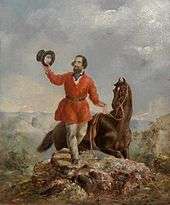
Flecks of gold were first discovered in the Fish River in February 1823, but it was 12 February 1851 in a Bathurst Hotel when Edward Hargraves announced the discovery of payable gold. Soon, gold was found at Ophir (later Sofala) and Hill End in the 1850s.
Hill End, called 'Bald Hills' in 1850, 'Forbes' in 1860 and finally Hill End in 1862 was part of the Tambaroora district. At it's peak had a population of 7 000 people. Hill End's fame is the finding of the 'Holtermann Specimen (Correctly the Beyers Holtermann Specimen)' on the 20 October 1871 being the largest single mass of gold ever discovered in the world, a record that still stands today. Found in 1872 this single mass of quartz and gold weighed 630 lbs and when crushed produced and est. of 3000 troy oz (205 lbs or 93 kg) of gold, thus processed held more gold then the processed gold from largest nugget ever found, that being the Welcome Stranger from the Victorian Goldfields. Holtermann recognizing the significance of the find attempted to preserve it by buying it from the Company of which he was one of a number of directors. His efforts were in vain. It is reported that a larger mass was discovered a few days later in the same mine but was broken up underground. Absolutely reliant on Gold, the towns decline was dramatic once the Gold ran out before the 1900's. Photo: Hotlermann with the Beyers-Holterman Specimen [23]
In the 1860s, the town of Bathurst began to boom. Bathurst was to become the first gold centre of Australia. The nearby gold localities would transport their gold to Bathurst[21] then to Sydney. The mail and gold transport coaches became an obvious target for bushrangers, which became a major problem for the authorities.
The Ribbon Gang and the Bathurst Rebellion occurred in 1830, when a large group of over 80 convicts roamed the Bathurst district. They were eventually captured and charged with murder, bushranging and horse-thieving. On 2 November 1830, ten members of the Ribbon Boys were hanged in Bathurst for their crimes. The site of the first and largest public hanging in Bathurst is still marked by the laneway sign Ribbon Gang Lane in the CBD.[24] Ben Hall, who became a notorious bushranger, was married in St Michael's Church at Bathurst in 1856. In October 1863, a gang of five (including Hall) raided Bathurst, robbing a jeweller's shop, bailed up the Sportsmans Arms Hotel and tried to steal a racehorse. They returned three days later and held up more businesses. John Piesley, another bushranger, was tried and hanged for murder at Bathurst Gaol in 1862.[25]
Bathurst's economy was transformed by the discovery of gold in 1851. One illustration of the prosperity gold brought to Bathurst is the growth and status of hotels and inns. The first licensed inn within the township was opened in 1835, the Highland Laddie. At the peak of hotel activity in 1875, coinciding with the gold rush period, there were 61 operating concurrently. A total of 89 hotel locations have been identified in the town of Bathurst, with 112 operating in the immediate district during the course of the history in Bathurst. Initially many pubs were simply a cottage with stables. As prosperity increased during the gold rush, the Hotels became typical of architecture of pubs known today.[26]
Development of the City (1860s) to Federation (1910)
The Cobb & Co. business was a horse drawn coaching transport business originally established in Victoria but relocated to Bathurst in 1862 to follow the gold rush. The business provided gold escorts, mail services and passenger services to the towns and rural settlements.[27] Cobb & Co. coaches were constructed in the coaching workshops located in Bathurst and the Bathurst Information Centre contains a restored Cobb & Co. coach.[28][29]
Bathurst later became the centre of an important coal-mining and manufacturing region. The Main Western railway line from Sydney reached Bathurst in 1876. From that time, the town became an important railway centre with workshops, crew base with locomotive depot and track and signal engineering offices. It remains today as the railway regional engineering headquarters with a large rail component manufacturing facility.
In 1885, Bathurst had a population of approximately 8,000 and a district population of an additional 20,000 people. The town in 1885 was a hub for stores such as E.G. Webb & Co. with supplies and distribution occurring throughout large parts of western NSW and into Queensland and South Australia.[21]
Federation (1910) and post war development (1940s)
This period is characterised by periods of slow to moderate population growth, with industrial and education industries developing and technology and services delivered to the town. Several major infrastructure developments arrive such as distributed town gas, electricity, town water supplies, and a sewage treatment system. Town gas had arrived in Bathurst courtesy of a private venture in 1872, with the Council providing a competing network from 1888. On 30 June 1914, the Council purchased the Wark Bros gas system and combined the gas networks. The old gasworks plant on Russell Street (now out of use) was built in 1960. In 1987 natural gas arrived via a new 240 km spur pipeline off the Moomba to Sydney pipeline.[30] The early part of the century saw electricity arrive initially for street lighting; the city converted from gas street lighting to electric lighting on 22 December 1924, when 370 electric lights at a cost of ₤40,000 were switched on.[31] Lighting spread along streets through to 1935, over time to businesses and finally private houses. Sewage treatment was an early infrastructure project funded by the state government and built in 1915.[32] Water supply started with private wells in backyards. Eventually a waterworks was built to the south of the town on the river with the water pumped through piping laid progressively to the businesses and private dwellings. In 1931, work started on the 1,700 ML Winburndale Dam project to gravity feed water through a wood stave pipe laid to the town. The scheme was opened by the Premier of New South Wales on 7 October 1933. Later, a new larger water supply dam was built on the Campbells River. Originally known as the Campbell River Dam scheme and later renamed the Ben Chifley Dam after the late Prime Minister Ben Chifley of Bathurst. It was opened in November 1956. The Ben Chifley Dam received a major storage upgrade designed to meet the cities needs to 2050; the work was completed in 2001 increasing the capacity by 30% to 30,800 ML.[33]
An ambulance service commenced on 6 June 1925 with a new Hudson ambulance. A new ambulance station was opened 2 March 1929 and is still used by the NSW Ambulance Service. Motor cars were becoming common in the early 20th century and the need for road service patrols commenced in 1927, provided by the NRMA using a motorcycle/sidecar response vehicle. The early electronic media age arrived with the opening of commercial radio station 2BS on 1 January 1937. Bathurst Aerodrome was opened in 1942, initially to benefit the war effort providing parking for aircraft overflowing from Richmond air force base.[34] The first commercial airline service departed for Sydney on 16 December 1946.[35]
A famous Australian brand name of frozen foods began in Bathurst. Robert Gordon Edgell arrived in Bathurst in 1902. By 1906, he was growing pears, apples and asparagus and experimenting with canning and preserving fruit and vegetables, eventually opening a small cannery in 1926. In 1930, he formed the company Gordon Edgell & Sons which became, and still is, a famous Australian food brand, now owned by Simplot.
Many attempts were made to start a University College, the earliest attempts were 1912 through to 1947 when real progress was made with plans for a state teachers college. The first intake of teacher students came at the beginning of 1951 with the official opening on 9 November 1951. The college has transformed over time into the Mitchell College of Advanced Education on 1 January 1970. The College grew and ultimately became the Charles Sturt University on 19 July 1989.
Bathurst was one of the locations to campaign to be the site of the new Federal Capital. In an essay prepared by a journalist with the Bathurst Times newspaper, Price Warung,[36] in 1901 to promote Bathurst's candidacy, he responds to the Federal committees key requirements for the capital to have: centrality and accessibility of situation, salubrity, and capacity for impregnable defence.[37]
An Army camp was established at Bathurst in early 1940 and was intended for the Second Australian Imperial Force's 1st Armoured Division, although it was later converted to an infantry training centre due to the unsuitability of the closely settled area to armoured training. Following the war, this camp was converted to a migrant reception and training centre. The first group of migrants arrived at Bathurst in 1948; at times the centre had up to 10,000 residents.[21]
Population growth
Bathurst's population has had rapid growth periods throughout its history; during the mid to late 19th century gold rush period, then post World War 2 when migrants from the war ravaged countries were settled in the area and returning soldiers were offered farming land, and at the start of this century has been another fast growth period corresponding in part to Sydney's congestion. Other periods have seen a slightly declining population, including the decade around the 1900s and during the 1960s. The following chart illustrates the growth from 1856 to recent times.[38]
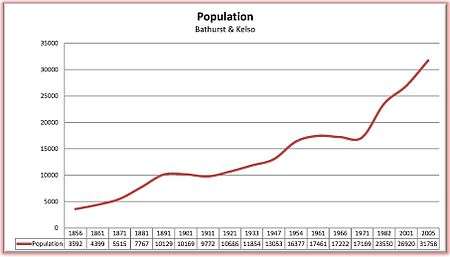
Governance
Local
Local government was trialled in the new Colony with a 'Bathurst and Carcoar District Council' established on 12 August 1843,[39] Bathurst was proclaimed a town in 1852 and incorporated as a borough in 1862, next a municipality in 1883,[5] then gazetted a city in on 20 March 1885.[21] the same day as Sydney was declared a city.[5] Bathurst Regional Council was formed on 26 May 2004 following the amalgamation of the Bathurst City Council, most of Evans Shire and a small amount of land formerly included in Oberon Shire.[40]
State
The Electoral district of Bathurst is the state seat in the NSW Parliament. This seat covers the major centres of Bathurst and Lithgow, and all or part of Bathurst, Blayney, Cabonne, Lithgow, Mid-Western and Oberon local government areas.
Since 1859, Bathurst has existed as an electoral district in the NSW Parliament. Prior to 1856, Bathurst was a part of the Electoral district of Western Boroughs. Before the 1920s, Bathurst was a single member constituency, in the 1920s it became a multimember district with proportional representation. During the middle part of the 20th century the seat was marginal between Labor and Country Parties, from 1981 when the strong Labor town of Lithgow moved from Blue Mountains to Bathurst, the seat was dominated by Labor, except for 1988 when it was won by the Liberal Party for one 3-year term,[41] and the 2011 election when Paul Toole of the National Party won the seat.[42]
Federal
Bathurst is currently within the federal electoral district of Calare which includes a large part of western NSW from Lithgow in the east to Tullamore in the west. Prior to the 2010 election, Bathurst was within the Macquarie federal electoral district which was more easterly based including the Blue Mountains area with Bathurst as the western boundary of the district.[43]
Economy
Bathurst's economy is broad based with a manufacturing industry, large education sector (including agricultural) and government service sectors. In 2015, the Gross Regional Product was $1.96 billion representing 0.4% of the Gross State Product of New South Wales.[44]
To capitalise on Bathurst's growth, education facilities and youthful population, in 2011 the Regional Council announced it was progressing plans for a new Australian Centre for Science, Technology and Emerging Industries (ACSTEI), also known as the Technology Park, to be established adjacent to the Charles Sturt University Campus with the centre featuring next generation emerging industries.[45]
Manufacturing and food
Private sector employers with large workforces in Bathurst (according to statistics published in 2009) include Devro, an international company that produces food casing products and Mars Petcare manufacturing plant are the single largest private employers of labour. Companies such as Telstra's call centre, Simplot Australia's (more recognisable as brands such as Edgells, BirdsEye, Chiko Roll, and I&J Seafood products) food processing and canning plant, Downer Rail's locomotive workshops, and Burkes Transport a local trucking and distribution company.[5]
Public sector
Government sector employers with large local workforces include Country Energy with their District Field Office and Corporate Office, Charles Sturt University, Bathurst Regional Council, the Land and Property Management Authority that provide mapping and survey data across NSW, the Greater Western Area Health Service – Regional Office, Bathurst Correctional Centre, Department of Education and Training – Regional Office, Police Service – Chifley Local Area Command, and NSW State Forests – Regional Office, and voestalpine VAE Railway Systems manufacturing workshops.[5]
Agriculture
The Bathurst region's climate of cool winter weather lends itself to stone fruit production and cool variety grapes suitable for wine production. The flood plains along the river suit the summer production of corn to supply the Simplot processing plant located in Bathurst.
Bathurst is the location for the Bathurst Primary Industries Centre, a government facility that has been operating since 1895 and originally known as The Experimental Farm. Originally established to study most facets of agriculture in the early growth years of the western inland, work included dairy, pigs, vegetable, cereal plantings, and fruit trees. The site is still one of the most important stone fruit research units in Australia.[46]
Sheep and wool production are the main primary industries in the surrounding area with beef cattle a secondary production. Wool has been a significant part of the Bathurst rural scene since the 1850s when the industry was growing rapidly. Lambs for meat production are a common product of the region's farms. Beef cattle breeds are predominantly British, British cross and European cross; the Bos indicus types are present but not common.[47]
Forestry
Bathurst is the site of a major timber processing facility, which uses timber harvested from the surrounding forests. There are large plantations of softwood timber (pinus radiata) that are harvested for timber products; the main product being sawlogs, and some pulp. Bathurst is the headquarters for the Macquarie Region of Forests NSW (a NSW Government Authority).[48]
Motorsport

Today, Bathurst is synonymous with motorsport, being the site of the Mount Panorama motor racing circuit. It hosts the Bathurst 12 Hour motor race each February, the Bathurst Motor Festival every Easter, and the Bathurst 1000 motor race each October. During these times, the population swells with tourists. The circuit is a public road when not being used for racing and is a popular tourist attraction for visitors to the city. Bathurst has a long history of racing, beginning with motorcycle racing from 1911.[49] From 1931 to 1938, motorcycle racing was conducted at the Old Vale Circuit[50] before moving to the newly created Mount Panorama Circuit in 1938. On 16 April 1938, Mount Panorama attracted 20,000 spectators to its first race, The Australian Tourist Trophy and in 2006 the crowd figure reached 194,000 for the 3-day Bathurst 1000 event.[51]
A group known as 'Mount Panorama Second Circuit Action Group' is promoting and lobbying to incorporate additional track and facilities into the existing circuit to capture additional events and increase the use of the facility.[52]
Beside the circuit is the National Motor Racing Museum. This museum was built to encourage visitors to the circuit all year round and includes motor cycles and cars, representing the racing history of Bathurst. Peter Brock, the race car driver, was synonymous with Mount Panorama racing and a memorial sculpture dedicated to him, is located in the museum grounds.
Sport
Sports in general are well supported by the Bathurst community. The Bathurst Regional Council and NSW State Government have contributed significant funds over the past decade to build new facilities, such as a new heated Aquatic Centre, an Indoor Sports Stadium, Hockey Complex and major upgrade of the track, new pit complex and spectator facilities at the Mount Panorama circuit. The Hockey Complex is an advanced facility which includes water and sand based fields as well as numerous grass fields. Bathurst has had a long association with competitive Hockey at the National level. The city provides dedicated sports facilities for motor racing, Rugby League (part of Group 10), Rugby Union, AFL, Athletics, Cricket, Netball, Tennis, Football and Touch Football. There are over 70 different sporting groups and organisations in the region from the Academy of Dance, croquet, aero, pony clubs, through to the football, rugby, cricket and cycling. Cycling is increasingly considered a speciality sport of the Bathurst Region with ideal road and community facilities around the city. The Bathurst Cycling Club is one of the oldest sports clubs in Australia founded in 1884.[53]
Sports grounds around Bathurst:[54]
- Alan Morse Park – cricket and athletics
- Anne Ashwood Park – rugby union (Bathurst Bulldogs Rugby Union Club)
- Bathurst Sportsground – turf cricket pitch, rugby league / rugby union field, velodrome, and turf 'track and field' facilities – home of Bathurst Panthers Rugby League Club & others
- Bathurst Indoor Sports Stadium – basketball, volleyball, netball, soccer and badminton courts
- Brooke Moore Oval – 3 synthetic cricket nets, and 1 turf cricket pitch
- Carrington Park – rugby league, and rugby union
- Cooke Hockey Complex – 9 grass hockey fields, 3 synthetic hockey fields
- Cubis Park Facilities – 2 synthetic cricket pitches, and 2 full size rugby league / soccer fields
- Eglinton Oval
- George Park – AFL, and cricket
- John Matthews Complex – 14 all weather netball courts, and tennis
- Learmonth Park – 4 synthetic cricket pitches, and 9 touch football fields (turf)
- Marsden Estate – table tennis tournament[55]
- Proctor Park – 12 turf soccer fields
- Police Paddock – 2 synthetic cricket pitches, and 4 full sized turf soccer fields
- Ralph Cameron Oval, Raglan – 2 tennis courts, 3 cricket nets, 2 synthetic cricket wickets
- Walmer Park
- Paddy's Hotel Sports Fields - turf cricket pitch, turf cricket nets and synthetic cricket nets
Gliding is a popular activity and there is a large gliding community in Bathurst. Gliding takes place at Pipers Airfield which is approximately 5 kilometres to the north of the city.[56] Gliding also occurs most school holidays at the Bathurst Regional Airport where Australian Air Force Cadets (AAFC) from No.301 Air Training Flight learn to fly.[57]
Bathurst, with its young demographic, has established modern sporting competitions such as the Newtons Nation event. At this event, held at Mount Panorama, young people can participate in modern sports such as BMX Dirt Bikes, Mountain Bikes, Wakeboarding, Parkour, Flatland BMX, Krumping, Skateboarding, and Luge.[58]
Culture
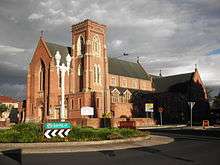
Bathurst is a cathedral city, being the seat for the Anglican and Roman Catholic bishops of Bathurst. The city is dotted with many churches and other religious buildings such as schools and halls. The cathedrals are All Saints' (Anglican), and St Michael and St John's (Catholic); then there are many churches and places of worship including St Stephens Presbyterian Church & Hall, Assumption Church (Catholic), St Barnabas' South Bathurst (Anglican) that was partially fire-destroyed in 2014[59] and others.
Bathurst was also the home of wartime Labor Prime Minister Ben Chifley, who represented the area in the Federal Parliament and is buried in Bathurst. His legacy is celebrated by the Labor Party each year with a function known as the Light on the Hill speech by a senior Labor figure. The Light on the Hill speech was first delivered to the ALP Conference by Chifley in 1949.[60]
Bathurst is unusual in that it has a collection of house museums representing different periods of its history from first settlement to the 1970s. The house museums include Old Government Cottage built 1837–1860,[61] Abercrombie House a 40-room historic mansion built c. 1870s, Miss Traill's House built in 1845, and Chifley Home which retains the simple furnishings that demonstrated the lifestyle and image of Chifley as a ‘plain man’.
Bathurst is home to several museums including the Bathurst Historical Society Museum located in the left wing of the historic courthouse. This museum includes in its collection a range of Aboriginal artefacts and large collections of documents relating to Bathurst's early history and collection of local items from Australia's early settlement.[62] Central Bathurst is host to the Australian Fossil and Mineral Museum, which houses the Somerville Collection of fossils and minerals, and features Australia's only complete Tyrannosaurus Rex skeleton. The Somerville Collection also consists of one of the largest collections of tourmaline in the Southern Hemisphere. The Fossil and Mineral Museum is located in the historic school building in the CBD.
Organisations that support the various arts are well catered for in Bathurst they include the Mitchell Conservatorium which was the NSW's first regional, community-based, pre-tertiary and non-profit music centre, it was established in May 1978. The Conservatorium provides musical education and performance opportunities to children and adults.[63] The Bathurst Regional Art Gallery focuses on Australian art from 1955 and has a strong representation of local landscapes and particularly local villages and towns. The collection includes several Lloyd Rees paintings. The design of the gallery allows regular exhibitions with an average of 25 exhibitions per year.[64] The gallery is owned by the Bathurst Regional Council and is located in a modern purpose built building incorporating the Regional Library.[65] Another Arts group is the Macquarie Philharmonia, this professional and amateur orchestra annually brings together professional musicians living in western areas of NSW. Known as Australia's Inland Symphony Orchestra, throughout the year the Macquarie Philharmonia invites selected music students from the region's Conservatoriums to perform alongside professionals to audiences throughout the Region.[66] Carillon Theatrical Society is an amateur theatrical society that has been performing musicals for the people of Bathurst since 1959. Recent shows include The Producers and Joseph and the Amazing Technicolor Dreamcoat.[67] The NSW Government and Charles Sturt University supports the Arts in the area through Arts OutWest which is the peak arts and cultural body for the Central West area of NSW, operating since 1974. This group promotes and educates arts and cultural development for Bathurst and the region.[68]
The Bathurst Memorial Entertainment Centre (BMEC) is a new purpose built building completed in 1999 that provides a venue for local and visiting performances. BMEC has an annual season of entertainment encompassing all forms of the performing arts from Australia and around the world.[69]
Entertainment and learning is promoted by the historic Royal Bathurst Show, this Agricultural Show has been operating since 1860 and is one of the largest regional shows in NSW. The show has been operating continuously from the present site since 1878 and attendances now typically reach 20,000 people over a two-day period. In 1994 approval was received from the Queen to name the show the Royal Bathurst Show.[70]
The Central Tablelands region is a location with a growing reputation as a producer of gourmet food and drink. A non-profit volunteer based organisation known as Bre&d was established in 2001 to encourage visitors and residents to experience the regions produce. The organisation operates the monthly Bathurst Farmers Markets held at the Bathurst Showground as well as the Bre&d Under the Stars and Bre&d On the Bridge annual events that showcase the regions chefs and local produce. The events are held on the historic Denison Bridge with the Macquarie River passing below.[71]
Attractions
- Yerranderie Regional Park
- Evans Crown Nature Reserve
- Abercrombie House
- National Motor Racing Museum
- Trunkey Creek
- Abercrombie Caves
- Bathurst Regional Art Gallery[72]
Education
Education is Bathurst's largest industry with 60 education facilities[73] that represent 7.6% of Bathurst’s Gross Regional Product. The education range covers all levels including university, TAFE, secondary, primary both public and private. 12.1% of the local population are employed in the education sector; the NSW state average is 7.0%.[74]
Bathurst is the headquarters for Charles Sturt University which has a major campus in Bathurst, complementing campuses in Wagga Wagga, Albury, Dubbo, Orange, Canberra, and Goulburn. It is a major provider of regional tertiary education. The university is renowned for its reputation in journalism.[75]
The Western Institute of TAFE has two campuses in Bathurst. The College has 12 Industry Training Divisions including arts and media, building and construction, business services, computing and information services, engineering services, rural and mining services and tourism and hospitality.[76] Western Sydney University has a clinical education facility, housed within Bathurst Hospital, open since June 2010 for its fourth year medical students.[77]
Bathurst has numerous primary schools and high schools, both public and private.[78] These include the All Saints College, Denison College, MacKillop College, St. Stanislaus College, The Scots School.
Transport
Roads
Bathurst is a regional highway hub. Several roads including the Great Western Highway, Mid-Western Highway, Mitchell Highway, O'Connell Road to Oberon and Bathurst-Ilford Road all start in Bathurst. Other major roads in Bathurst include Durham Street, Eleven Mile Drive, and Bradwardine Road.
Rail
Bathurst railway station is located ten minutes' walk from the city centre. It is serviced by daily NSW TrainLink trains and buses east to Lithgow then on to Sydney, north west to Dubbo, west to Parkes and south to Cootamundra.[79] [80]
Bus
Local bus services provided by Bathurst Buslines operate in the surrounding suburbs of Bathurst,[81] with a bus interchange in Howick Street, opposite Stockland Bathurst.
Interurban bus services are provided between Bathurst and Lithgow, Bathurst and Orange, and Bathurst and Oberon. Long distance coaches also operate between Bathurst and Sydney.
Air
Regional Express Airlines is the only airline providing passenger services at Bathurst Airport; it services the route with three daily return flights to Sydney.[82]
Bathurst Region development
Bathurst’s location close to Sydney and on major highways placed it in a desirable position for decentralisation plans by various governments over the years. Several decentralisation plans relating to Bathurst can be identified:
- in the late 1940s the Curtin Federal Government encouraged the NSW government to establish regions for regional development purposes. Bathurst and Orange were grouped as the Mitchell Region and established as such in 1945. Later the new Menzies federal government dropped support for the regionalisation scheme however the NSW Government continued, albeit modestly, promoting the regionalisation plan.[83]
- on 3 October 1972 the Federal Government and New South Wales Governments agreed on a plan to introduce a decentralisation policy to various regions in NSW. This plan included a pilot growth centre in the Bathurst-Orange area and was known as the Bathurst Orange Development Corporation (BODC). Initially 13 areas were proposed, however only four were established with Bathurst-Orange and Albury-Wodonga the only in rural regional NSW.[83] The project would comprise domestic, commercial and industrial developments and would develop the area economically, raise new capital investment, bring population to the region and create new employment opportunities. A statutory body was established by Act of Parliament to manage the BODC. The Act was effective from 1 July 1974.[84] A key focus for the BODC was the purchase of land and to that end it purchased 209 properties around Bathurst valued at $22 million.[83] A decline in regional trade as a result of changing global trends and the international depression and the oil shock during the mid-70s resulted in a declining interest by developers in new facilities. The BODC progressively received less and less government support and suffered liquidity problems.[85] Several large new employers moved to Bathurst as part of the BODC initiative, including Devro, Uncle Bens (now Mars), and Omya Minerals.
- In 1989, the Greiner government promoted the regional hub strategy that encouraged regional centres that had natural growth potential. Bathurst was one of 12 regional hub locations in NSW that received support funding for development of University expansions, administration, health and general education sectors.[83]
- In 2010, a new plan to attract residents and therefore business to regional centres was launched. The marketing name is EVO Cities, a name coming from Energy, Vision and Opportunity (EVO). Seven NSW regional cities including Bathurst have developed the EVO City strategy at a local government level with funding provided by the NSW and Federal governments.[86] The strategy largely relies on advertising in capital city markets to promote residents to relocate to the EVO Cities.
Notable people from Bathurst
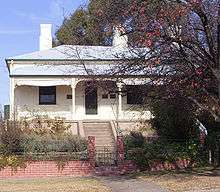
- Lord Bathurst (1762–1834), British politician
- Charles Bean (1879–1968), barrister, journalist, war correspondent and historian, born in Bathurst
- George Bonnor, (1855–1912), Australian cricketer
- Brian Booth (1933–), test cricketer and Olympic hockey player
- Peter Brock AM (1945–2006), motor racing legend, known as The King of the Mountain, referring to Bathurst's Mount Panorama
- Reg Campbell (1923–2008), Australian portrait painter
- Ben Chifley (1885–1951), Australian Prime Minister and Bathurst loco driver
- Brendan Cowell (1976–), actor, screenwriter and director
- William Cox (1764–1837), engineer of the first road from Sydney to Bathurst
- Andrew Denton (1960–), producer and host of Enough Rope
- Robert Gordon Edgell (1866–1948), founder of Edgells food processing[87]
- George William Evans (1780–1852), first European to reach site of Bathurst
- Beatrice Grimshaw (1870-1953), noted for her writing about New Guinea, buried in Catholic portion of cemetery.
- Gus Kelly (1890–1967), Member for Bathurst for 38 years
- Janelle Lindsay, OAM[88] Australian Paralympic tandem cycling pilot.
- Kim Mackay (1902–1960), British Labour politician
- Scott McGregor (1957–), Television presenter, actor
- James Thomas Morisset (1780–1852), was appointed Commandant at Bathurst in 1823
- Matt Naylor (1983–), Australian field hockey player
- Peter O'Malley (1965–), Australian professional golfer
- Mark Renshaw (1982–), Australian professional cyclist, born and educated in Bathurst[89]
- Beau Robinson (1986–), Australian rugby union player
- Rodney keft (A.K.A. Rodney Rude) (1943–) Australian comedian
- Gordon Neil Stewart (1912–1999), Author and journalist
- Tim Storrier (1949-), Australian painter, winner of the 2012 Archibald Prize. Resident of Bathurst 1995-2013.
- Sir Francis Bathurst Suttor, a local politician and pastoralist
- William Henry Suttor, (1805–1877), a local politician and pastoralist
- Archie Thompson (1978–), A-League record-holding footballer
- Charles Turner (1862–1944), Australian cricketer
- B. Linden Webb (1884–1968), Methodist minister and pacifist
- Bluey Wilkinson (1911–1940), Australian speedway rider, Individual World Champion in 1938, known as the Bathurst Burr[90]
- Windradyne (c. 1788–1835), Wiradjuri Warrior
Media
The local daily newspaper is the Western Advocate, published in Bathurst for 150 years. The publication has a circulation of 5,800 copies.[91]
Radio stations
Bathurst-licensed stations
- 2BS 1503 AM (commercial) – transmitted from the broadcasters own tower in the northern suburb of Eglinton
- B-Rock FM 99.3 (commercial) – transmitted from the broadcasters own tower in the Ovens Ranges near Yetholme
- 2MCE-FM 92.3 (community)
- Life FM 100.1(Christian community)- transmitted from the Bathurst broadcast site Yetholme
National and other stations
- ABC Central West 549 AM
- NewsRadio 98.3
- Radio National 104.3/96.7
- Triple J 101.9/95.9
- Classic FM 102.7/97.5
- SBS Radio 88.9 MHz -Special Broadcasting Service, (Multicultural)
- Vision Radio (UCB relay) 1629 AM
- Racing Radio 2KY 100.9
Television stations
Television in the town area is transmitted from a tower on Mount Panorama 33°27′01″S 149°32′50″E / 33.45028°S 149.54722°E
- Prime7, 7Two, 7mate, 4ME, (Seven Network affiliated channels).
- WIN Television, One, Eleven, Gold, (affiliated with Network Ten Australia/WIN Television).
- Southern Cross Nine, 9Gem and 9Go (Nine Network Australia).
- (ABC Television) including ABC1, ABC2, ABC3 and ABC News 24, part of the Australian Broadcasting Corporation.
- Special Broadcasting Service, SBS ONE and SBS Two.
- Local half-hour long news bulletins are broadcast by Prime7 and WIN.
Subscription Television services are provided by Austar.
Twin city
History gallery
This gallery of images illustrates the heritage and architectural styles of various buildings and structures and localities in the City of Bathurst.
 Holy Trinity Church
Holy Trinity Church Carillon
Carillon Bathurst Base Hospital (old section)
Bathurst Base Hospital (old section) Kings Parade
Kings Parade
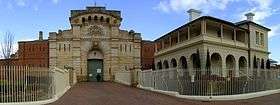
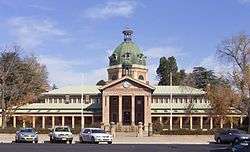 Bathurst Court House
Bathurst Court House Commercial Hotel
Commercial Hotel Court House and old Post Office
Court House and old Post Office Bathurst Railway Yard
Bathurst Railway Yard Boer War Memorial
Boer War Memorial.jpg) St Stephens Presbyterian Church
St Stephens Presbyterian Church
See also
- History of infrastructure development in Bathurst a sequence of significant infrastructure building events in the growth of Bathurst
- Bathurst County one of the 141 Lands division areas within NSW, now only used for land titles and geographic surveying
- New South Wales gold rush
References
- 1 2 "3218.0 – Regional Population Growth, Australia, 2015-16: Population Estimates by Significant Urban Area, 2006 to 2016". Australian Bureau of Statistics. Australian Bureau of Statistics. 30 June 2016. Retrieved 17 July 2017. Estimated resident population, 30 June 2015.
- ↑ "A Brief History of Bathurst & its surrounding areas". Bathurst NSW. Highway West. 2010.
- ↑ "The Australian gold rush". Web Story. Commonwealth of Australia. 5 October 2007. Retrieved 10 August 2011.
- ↑ "Regional Population Growth". Australian Bureau of Statistics. 11 November 2006. Retrieved 20 March 2011.
- 1 2 3 4 5 6 "Bathurst Statistical Profile" (PDF). Bathurst Regional Council. 2009. Retrieved 25 March 2011.
- ↑ Australian Bureau of Statistics (31 October 2012). "Bathurst (SUA)". 2011 Census QuickStats. Retrieved 21 October 2012.

- ↑ Freebray, W (May 1998). "Mitchell Occasional Paper in Geography" (PDF). Greening Australia. Archived from the original (PDF) on 14 October 2009. Retrieved 20 March 2011.
- ↑ "Bathurst-kelso Railway Bridge". NSW Government - Office of Environment & Heritage. 2010. Retrieved 2 March 2017.
- ↑ Grant, C (April 2001). "Sedementary case study". Archived from the original on 10 April 2011. Retrieved 27 March 2011.
- ↑ "Australias three main climate zones". Bureau of Meteorology. Archived from the original on 6 June 2011. Retrieved 23 March 2011.
- ↑ "Cool Temperate Zone". Bureau of Meteorology. Archived from the original on 6 April 2011. Retrieved 23 March 2011.
- ↑ "About Severe Thunderstorms". Bureau of Meteorology. 2011. Retrieved 23 March 2011.
- ↑ "BATHURST AGRICULTURAL STATION". Climate statistics for Australian locations. Bureau of Meteorology. January 2014. Retrieved 25 January 2014.
- ↑ "Local Council Boundaries". Division of Local Government. Government of New South Wales. 9 April 2010. Retrieved 20 March 2011.
- ↑ Harvey, Spencer (November 2010). Kings Parade, from Market Place to City Centre. Bathurst: Bathurst Regional Council. pp. 34–41.
- ↑ "Carillon" (PDF). Website. Bathurst Regional Council. Retrieved 31 March 2011.
- ↑ "William Cox". Dictionary of Australian Biography. Project Gutenberg Australia. Archived from the original on 13 July 2011. Retrieved 12 August 2011.
- ↑ Local History, Bathurst City, Bathurst Visitor Information Centre(accessed 10 October 2013)
- ↑ "NSW Proclamation". Newspaper. Australia Trove. 23 December 1824. Retrieved 10 August 2011.
- ↑ Macquarie, Lachlan (2011). "Lachlan Macquarie 1818". The Lachlan & Elizabeth Macquarie Archive. Macquarie University Library. Retrieved 10 August 2011.
- 1 2 3 4 5 Bathurst City Council (1985). Bathurst Civic Centenary Souvenir. Bathurst: BCC. p. 19.
- ↑ "Blue Mountains History". The Impact of Exploration. Western Sydney Libraries. Retrieved 23 August 2011.
- ↑ Australian History of Biography, Bernard Otto Holtermann.
- ↑ "Abercrombie Caves". Web. abercrombiecaves. Retrieved 12 May 2011.
- ↑ "Major historic city on the western side of the Great Dividing Range". Sydney Morning Herald. 1 January 2009. Retrieved 31 March 2011.
- ↑ Tighe, W. H (1992). Inns and Hotels of Bathurst. Bathurst: W H Tighe. p. 107.
- ↑ "Cobb & Co Restoration" (PDF). Bathurst Regional Council. Retrieved 20 March 2011.
- ↑ "Cobb & Co". Visit Bathurst.com. Retrieved 20 March 2011.
- ↑ "Welcome to Cobb & Co". Cobb & Co Heritage Trail Website. Retrieved 20 March 2011.
- ↑ "NSW, the new frontier". website. The Australian Pipeliner. October 2009. Retrieved 14 April 2011.
- ↑ "Bathurst Electric Light Scheme". The Sydney Morning Herald. Australia Trove. Retrieved 10 August 2011.
- ↑ Kass, Terry (June 2003). "Thematic History – Central West" (PDF): 59.
- ↑ "Inquiry into secure and sustainable water" (PDF). Bathurst Regional Council. 2008. Retrieved 13 April 2011.
- ↑ Barker, Theo (1985). A Pictorial History of Bathurst. Robert Brown and Associates. pp. 115 of 198. ISBN 0-909197-97-0.
- ↑ "Butler Air Services" (Advertisement). Sydney Morning Herald. 14 April 1948. Retrieved 23 March 2011.
- ↑ "Astley Warung". Australian Dictionary of Biography. 2006. Retrieved 23 March 2011.
- ↑ Whalan, Glyndwr (1901). "Bathurst the ideal site for the Federal Capital" (PDF).
- ↑ Barker, Theo (1985). A Pictorial History of Bathurst. Bathurst: Robert Brown and Associates. pp. 190–191. ISBN 0-909197-97-0.
- ↑ Kass, Terry (June 2003). "Thematic History – Central West" (PDF). NSW Heritage Office: 66.
- ↑ "Bathurst Regional Profile". Bathurst Regional Council. 2011. Archived from the original on 13 March 2011. Retrieved 19 March 2011.
- ↑ "Bathurst NSW 2011". 2011. The Tally Room Website. Retrieved 24 March 2011.
- ↑ "State Electoral District of Bathurst". NSW State Electoral Commission. 27 March 2011. Archived from the original on 26 March 2011. Retrieved 27 March 2011.
- ↑ "Profile of the electoral Division of Calare". Website. Australian Electoral Commission. 23 February 2011. Retrieved 24 March 2011.
- ↑ http://economy.id.com.au/bathurst/home
- ↑ "Technology Park". Bathurst Regional Council. Archived from the original on 13 March 2011. Retrieved 20 March 2011.
- ↑ "Bathurst Primary Industries Centre". NSW Department of Industries and Investment. Retrieved 27 March 2011.
- ↑ Davies, Lloyd. "Recent beef production and management system trends in NSW". NSW Department of Primary Industries. Retrieved 27 March 2011.
- ↑ "Regional map – planted forest" (PDF). Primary Industries – Forests. Retrieved 27 March 2011.
- ↑ "Motor Racing". Bathurst region – tourism information. Bathurst Regional Council. 2010.
- ↑ "Motor Racing – Vale Circuit". Bathurst region – tourism information. Bathurst Regional Council. 2010.
- ↑ "Circuit History". Mount Panorama.com. Retrieved 20 March 2011.
- ↑ "Mount Panorama Second Circuit Feasibility Study" (PDF). Homebush Motor Racing Authority. 24 November 2010. Retrieved 20 March 2011.
- ↑ "Sport & Recreation". bathurstregion.com.au. Retrieved 20 March 2011.
- ↑ "Sports Facilities". bathurstregion.com.au. Retrieved 20 March 2011.
- ↑ "Marsden Table Tennis Federation". Marsden Table Tennis Federation. 2011. Retrieved 5 February 2012.
- ↑ "Bathurst Soaring Club – about us". Bathurst Soaring Club. 2005. Retrieved 20 March 2011.
- ↑ "News – Australian Air Force Cadets Hit The Sky". Australian Air Force Cadets. 14 November 2010. Archived from the original on 12 March 2011. Retrieved 20 March 2011.
- ↑ "Newtons Nation – Mt Panorama". The Bathurst Town & Around Website. 2011. Retrieved 20 March 2011.
- ↑ "Historic St Barnabas church in Bathurst destroyed by suspicious fire". ABC News. 23 February 2014. Retrieved 25 February 2014.
- ↑ "Light on the Hill Speech". Australian Politics.com. Retrieved 21 March 2011.
- ↑ "Old Government House". NSW Heritage Council. 2008. Retrieved 21 March 2011.
- ↑ "Bathurst District Historical Society". Bathurst District Historical Society. 2011. Retrieved 19 March 2011.
- ↑ "Mitchell conservatorium – About us". Mitchell Conservatorium. 2011. Retrieved 19 March 2011.
- ↑ "Art & Culture". Bathurst Region.com.au. 2011. Retrieved 19 March 2011.
- ↑ "BRAG". Bathurst Regional Art Gallery BRAG. 12 November 2010. Retrieved 19 March 2011.
- ↑ "Macquarie Philharmonia". Macquarie Philharmonia. 2008. Retrieved 19 March 2011.
- ↑ "Theatre Group facing the final curtain". Western Advocate. 9 July 2010. Retrieved 20 March 2011.
- ↑ "Arts OuWest". Arts OutWest. 2009. Retrieved 19 March 2011.
- ↑ "Bathurst Memorial Entertainment Centre". Bathurst Memorial Entertainment Centre. 2011. Retrieved 19 March 2011.
- ↑ "Bathurst A,H&P Association – About Us". Bathurst A,H&P Association. 2011. Retrieved 19 March 2011.
- ↑ "Welcome to Bre&d". Bathurst Region Eats and Drinks. 2011. Retrieved 19 March 2011.
- ↑ "Things to Do in Bathurst | Bathurst Attractions". VisitNSW.com. Retrieved 2017-05-23.
- ↑ "Bathurst Regional Council – Study". Bathurst Regional Council. 2011. Archived from the original on 13 March 2011. Retrieved 19 March 2011.
- ↑ "BRC Autumn Winter Profile 2007" (PDF). Bathurst Regional Council. 2007. Retrieved 19 March 2011.
- ↑ "Courses as CSU". Charles Sturt University. 2010.
- ↑ "Community – Emergency contacts – Bathurst TAFE". Bathurst Regional Council website. Bathurst Regional Council. 2010.
- ↑ "Rural Clinical Schools". Bathurst Rural Clinical School. University of Western Sydney. 2011.
- ↑ "Bathurst Schools – Education & Training – Art, Beauty, Cooking, Flying Schools". Bathurst NSW. Highway West. 2010.
- ↑ "Western timetable" (PDF). NSW Trainlink. 20 October 2013 [Updated 15 June 2013].
- ↑ "Southern timetable" (PDF). NSW Trainlink. 20 October 2013 [Updated 30 June 2014].
- ↑ "Bathurst Buslines". Bathurst Buslines. Retrieved 10 June 2015.
- ↑ "Website". Regional Express Airlines. 2011. Retrieved 19 March 2011.
- 1 2 3 4 Wilkinson, John (June 2003). "Regional Development outside Sydney" (PDF). NSW Parliamentary Library Research Service. p. 33. Retrieved 19 March 2011.
- ↑ "Bathurst-Orange Development Corporation". Department of Services, Technology & Administration. Retrieved 19 March 2011.
- ↑ Gregory, Denis (18 July 1988). "Profitable Qango nearly went west". The Sydney Morning Herald. Retrieved 19 March 2011.
- ↑ "EVO Cities Bathurst". evocities.com. 2010. Archived from the original on 20 March 2011. Retrieved 19 March 2011.
- ↑ "Edgell History". Simplot corporate website – About us. Simplot Liimted. 2010. Archived from the original on 28 August 2007.
- ↑ http://www.itsanhonour.gov.au/honours/honour_roll/search.cfm?aus_award_id=1057962&search_type=quick&showInd=true
- ↑ "Mark Renshaw". Cycling Australia. 25 July 2011. Retrieved 26 January 2012.
- ↑ "A tribute to Arthur George Wilkinson". Australian Vintage Speedway. Brian Darby. 2010.
- ↑ "Western Advocate". Rural Press. Retrieved 26 March 2011.
- ↑ "Sister City" Archived 26 February 2012 at the Wayback Machine., Bathurst Regional Council
- ↑ "Bathurst's sister city home to nuclear plant" Archived 6 July 2011 at the Wayback Machine.
Books
- Bathurst Progress Committee (ed) (1893), Bathurst guide: embracing particulars descriptive of the rise and progress of the city and its public institutions including illustrations of the principal buildings, parks and scenery of the district, John Sands
- Salisbury, T; Gresser, P J (1971), Windradyne of the Wiradjuri; martial law at Bathurst in 1824, Wentworth Books, ISBN 0-85587-017-6
- Greaves, Bernard (ed) (1976), The story of Bathurst (3rd ed.), Angus & Robertson, ISBN 0-207-13363-8
- Barker, Theo (1992), A history of Bathurst: The early settlement to 1862, Crawford House Press, ISBN 1-86333-056-9
- Raxworthy, Dorothy Sampson (1993), The making of a settlement: Bathurst Kelso NSW, 1813–1833, D.S. Raxworthy, ISBN 0-646-13920-7
- Barker, Theo (1998), A history of Bathurst: From settlement to city 1862–1914, Crawford House Press in association with Bathurst City Council, ISBN 1-86333-058-5
- Scaysbrook, Jim (2003), Bikes & Bathurst: a history of racing at Bathurst since 1931, Independent Observations, ISBN 0-9581758-0-2
External links
| Adjacent places of Bathurst, New South Wales | ||||
|---|---|---|---|---|
 |
Dubbo | Sofala & Mudgee |  | |
| Orange | |
Lithgow & Sydney | ||
| ||||
| | ||||
| Blayney | Oberon | |||
